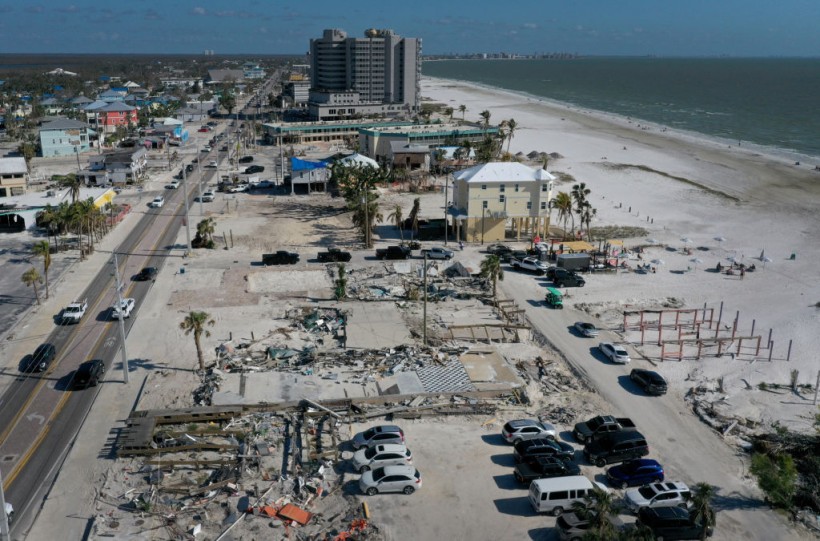To better improve the weather, hurricanes and climate forecasting, reports showed that experts finally launched missions to observe rapid changes in storms and hurricanes.
In the United States, Americans are no strangers to severe extreme weather events, causing significant damage to lives and properties.
In the CBS News report, 18 extreme climate events in the United States resulted in significant damage.
Reports revealed that Hurricane Ian was considered one of the costliest that struck the U.S., leaving about $112.9 billion. Many Americans were displaced after Hurricane Ian unloaded powerful rain and winds.
Other than extreme weather events, prolonged drought conditions unfolded in the country.
Better hurricane and climate forecasts

January 25, 2023 in Fort Myers Beach, Florida. The latest reports revealed that missions were finally deployed to help enhance the forecasting of hurricanes and climate, showing the potential changes in a developing storm.
In the reports published in AccuWeather and CNN, the said loaf-size mission could significantly improve hurricane forecasts.
The size of the four satellites may look like a size of a loaf of bread, but it plays a crucial role in monitoring potential storm systems or cyclones.
Reports added that the two CubeSats were recorded in Mahia, New Zealand on Sunday, noting that the said NASA Mission has so-called TROPICs or the Time-Resolved Observations of Precipitation.
The mission's success shows helpful weather forecasting that could help communities anticipate and predict a storm system.
Having improved weather forecasting can provide immediate information for evacuations and disaster preparations.
Based on the reports, the first mission's name was Rocket, like a hurricane. Meanwhile, the other CubeSats were Coming to a Storm Near You.
The satellites' potential contribution could help scientists and experts look into the changes in the weather or storm.
More facts about Hurricanes in the U.S.
According to the National Oceanic and Atmospheric Administration (NOAA), hurricane season is expected to start on June 1 and finally end on November 30.
The report noted that there could be 12 times on average that could emerge in the Atlantic Basin.
As mentioned, U.S. residents are no strangers to severe and extreme hurricane conditions, mainly when Hurricane Ian emerged.
Also Read: 4 Facts About 1993 Storm of Century in United States
According to NOAA's National Hurricane Center, other powerful hurricanes have been unleashed in the United States.
The NOAA-NHC reported that Hurricane Rita 2005 reached a category five hurricane that struck portions of southwestern Louisiana, southeastern Texas and the Florida Keys.
The report noted that the powerful hurricane managed to cause strong winds and flooding that caused about $10 billion in the U.S.
Reports also said that Hurricane Katrina left a devastating aftermath in the U.S., causing a whopping $75 billion in damage in portions of New Orleans and Mississippi coast.
The devastating Hurricane Katrina resulted in 1200 reported casualties.
To read more about other hurricanes that impacted the United States, visit here.
Preparing for the hurricane season
As the hurricane season is expected to begin, Americans must prepare for the potential powerful hurricanes.
Staying updated with the weather is helpful. In addition, it is best to check houses for potential repairs.
Related Article: Global Temperatures, Heatwaves to Rise As El Niño Expected in 2023
For more similar stories, don't forget to follow Nature News.
© 2024 NatureWorldNews.com All rights reserved. Do not reproduce without permission.


![Climate Change is Reducing Dust Levels Worldwide as Arctic Temperature Warms [Study]](https://1471793142.rsc.cdn77.org/data/thumbs/full/70320/280/157/50/40/climate-change-is-reducing-dust-levels-worldwide-as-arctic-temperature-warms-study.jpg)

![Tsunami Hazard Zones: New US Map Shows Places at Risk of Flooding and Tsunamis Amid Rising Sea Levels [NOAA]](https://1471793142.rsc.cdn77.org/data/thumbs/full/70325/280/157/50/40/tsunami-hazard-zones-new-us-map-shows-places-at-risk-of-flooding-and-tsunamis-amid-rising-sea-levels-noaa.jpg)
